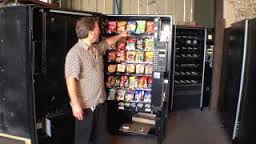
Simply put, being able to keep a tab on inventory and sales of your machines is yet another important foundation to a smooth and successful vending machine venture. Doing it in an efficient and organized fashion is the goal, but difficult without the right resources. One already has to collect and note down this information on every single visit to setup machines, which sooner or later can easily amount to dozens of separate sheets to deal with at a time, then compile it on a just-as-frequent basis in a separate program, hoping it’s been done right and can actually be read and understood fully. Not to mention separating these compilations out into various categories, either by machine/product type (if having multiple under your belt), location, or other factor, some of which may intercross. Then having these FINAL results listed and organized in a separate, easy-to-follow source (old school focusing on things like folders, graphs, tables, etc), which one needs to make sure they actually analyze every month or two so as to pay attention towards important trends. Though in one’s first year or two of business the importance of this is mainly to get a better, more finite understanding of how your sales do from seasonality and other trends.
 On the Street
On the Street
Let’s just go ahead and put it as it is. End of the day, you’re going to have to record the inventory down in-person, at the machine during maintenance and refills. No business own/manager is going to spend any extra time and attention to do YOUR job for you (from their point of view). This means having yourself or whoever you send out to deal with planted machines to note how much has sold since last time. Detailed record-keeping, and having a physical or electronic folder of each machine at each location for review with how much previous sold and then refilled, is pretty much mandatory so as to do this smoothly and accurately.
This can be done with notepads or some technological medium to then be transferred into an excel sheet, whatever initially feels good for you. Though there’s a particular option we’ll mention in a bit that we suggest heavily looking into.
There ARE Telemetry or other systems out on the market that one can install into the machines which will tell you, on average, what’s selling out of the machines. However this is often a notably less cost-effective method. Another benefit of this, however, is that it allows you to assemble better, more refined pre-kits (what you’re bringing to refill the machines) at a faster and more efficient production. This as opposed to always bringing an average number of certain products every time, or relying on the area owner/manager to tell you (which, again, you probably shouldn’t).
Accounting for Sales
Other guides and people in the business will say that the actual sales and profits, the simple act of collecting your machine money, should be done daily. Though in reality I believe this is rather dependant on your operation; what exact kind of machine do you have, HOW well is it actually doing/purchase average, where is it located, how MANY machine locations do you have? There’s not much use in collecting every day if it only makes a few spare purchases in that period, especially if one only has so many employees and so much time to spend with the business (if not just YOURSELF to go and collect). As the business rolls, locations expand, interest and rate of sales go up along with people you hire on, then this will certainly be a good thought to start considering. One can then use these frequent daily runs to keep semi-track of when a machine next needs a refill, and with what, thus making efficient pre-kits without the need for telemetry systems.
When gathering sales for a period, the method remains simple, just like counting the inventory of a machine. Simply counting out cash and recording; so long as one does it accurately, with separate boxes/envelopes/folders/etc for separate machines, with proper slots for easy tallying of each bill and coin, then you’re golden.
style=”display:inline-block;width:728px;height:90px”
data-ad-client=”ca-pub-9542823151794952″
data-ad-slot=”9174899213″>
If the machine accepts Credit Cards (probably best to have one that does in this day and age), you MUST make sure to account for those as well, and do it separate from the cash. This is vital considering the charge these card companies charge for you to accept their card payments, and your accounting entry must reflect this before applying it to the total. Which should first be done to that particular machine, in that period, before being combined with the sales of them all as a whole.
Software
Once you’re at the point of gathering information, the question comes to where it should all be inputted. We could try to put this, week after week, into Spreadsheets like Excel, or even go old-school and keep it all written down, but that requires a LOT of extra work and organization, file after file of records that have to be saved and kept, input one at a time to then be brought up again later on for converged reports. Machine by machine and all together, which you need to look at on daily, weekly, monthly, seasonally, and yearly basis’ to get a better idea of the business, and that means scrolling through these various sheets on a regular basis.
Or, you could get some software to hold all this data for you. It may cost some money, but there are various programs out there specifically designed to help vending machine owners in practically every task, from maintaining locations to route management to inventory and sales tracking. The efficiency created through these can heavily impact your business in a positive way, and best of all you can connect to them from anywhere. So one can bring a phone or (ideally) tablet with them on their route, enter the sales and inventory information (along with any other business aspects handled at the time) into the system’s proper database on-site or whenever it’s counted (some people like counting money back at the office afterall), and it applies all the further work for you after that.
Vend-Trak is one of the most popular and established one out there for people to use, and includes a 14-day Free Trial. We certainly suggest that, when getting to that point, try it out, look into it and/or some other software, and start to turn your entrepreneurial path into a full, smooth operation.






